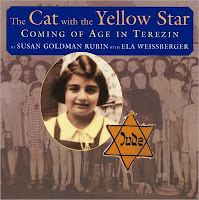The Cat with the Yellow Star is the true story of Ela Weissberger and her life before, during and after the part of her childhood that she spent in Terezin.
Ela and her family were living in the Sudetenland when the Nazis took control of this area of Czechoslovakia. The family decided to move to Prague, but not before her father, Max Stein, was arrested by the Nazis for speaking out against Hitler. Ela never saw him again.
Not long after arriving in Prague, Jewish children were prohibited from to attend school, all Jews were forced to wear a yellow star, and in 1941, deportations began. In 1942, Ela, age 11, and her family were sent to Terezin. For a while, Ela lived with her mother in a barrack, but her mother soon sent her to live in a barrack designed for girls only. There were 28 girls altogether and began to make Ela lots of friends. The caretaker in her barrack, Tella, was very strict about hygiene even under the terrible conditions of the camp, making sure the girls kept the barrack clean, the bedding was aired out everyday to fight the bedbugs and lice they were plagued with and having the girls wash daily even if the water was ice cold.
But Tella also taught them songs and made sure they did their schoolwork, both of which were forbidden and accomplished in secrecy. Also forbidden was any descriptions of the camp, whether in writing or drawing, but the well-known artist Friedl Dicker-Brandeis was also in Terezin and brought the children art supplies to use under her supervision.
Also in Terezin was composer Hans Krása, who had written the children’s opera Brundibar as an anti-Nazi work. In 1943, he reworked it and it was announced that Brundibar was going to be performed. Ela was cast to play the part of a cat. The Nazi officers were very capricious about allowing cultural activities, but play was allowed to rehearse several times in the summer on 1943. Brundibar was preformed a number of times during 1943-1944. Sadly, as children were deported, their parts were taken over by other kids. Ela, however, was fortunate enough to have never been deported and therefore, never missed any of the 55 performances that were given and always played a cat.
 |
| Original performers in Terezin's production of Brundibar |
Unfortunately, after this visit, deportations increased considerably and soon there were only three girls left in the barrack besides Ela. Then, in the early spring of 1945, hundreds of people suddenly began streaming into the camp. They were the survivors of the Death March from Auschwitz to Terezin. Among them was Ela’s old friend Helga. Helga told Ela about what life was like in an extermination camp and Ela finally understood what the meaning to “sent to the East” meant. On May 3, 1945, Terezin was liberated and turned over to the International Red Cross.
Ela Weissberger lived in Terezin for 3 ½ years, making many friends there. After the war, she lived in Israel and later, she moved to Brooklyn, NY. On a trip to Europe in the 1970s, she discovered her friend Helga living in Vienna. A reunion of the girls from Ela’s barrack was arranged and they discovered that altogether 15 of them had survived.
Brundiabar seemed to have been lost to history, until renewed interest in it began in 1987. Since then it has been preformed fairly frequently, and Ela has been able to attend performances many times. Ela also spends time speaking to school groups about her experiences in Terezin.
The Cat with the Yellow Star is an excellent book for young readers containing a wealth of information. There are photographs of Ela’s family, copies of the art work she produced in Terezin and some wonderful pictures of her with her friends after they founded each other again in the 1970s. This was an interesting first-hand account of life in a ghetto/concentration camp that was always different from the others. Theresienstadt stands as an example of how clever the Nazis were at deception and propaganda. It was a place that they used to deflect interest away from what they were doing in the other camps and yet, of the 10,632 children sent to Terezin, only 4,096 survived.
A very nice compliment to The Cat with the Yellow Star is the 2003 story of Brundibar retold by Tony Kushner (Angels in America) and illustrated by Maurice Sendak. Unfortunately, the opera's composer Hans Krása was sent to Auschwitz and killed in October 1944 at the age of 45.
This book is recommended for readers age 9 to 12.
This book was borrowed from the Webster Branch of the NYPL.
An interesting interview with Ela Weissbergermay be found at Jweekly.com
Holiday House offers an excellent Educators Guide for The Cat with the Yellow Star.
Non-fiction Monday is hosted this week bySimplyScience Blog




What a heartbreaking story. The true stories that come out of WWII never cease to amaze me. I can't even imagine all the stories we lost.
ReplyDeletehttp://www.ManOfLaBook.com
Yes, all Holocaust stories are heartbreaking, but I think it is important to talk about them.
ReplyDeleteThanks, Alex, for this thought-provoking post.
ReplyDeleteSounds sad story..
ReplyDelete